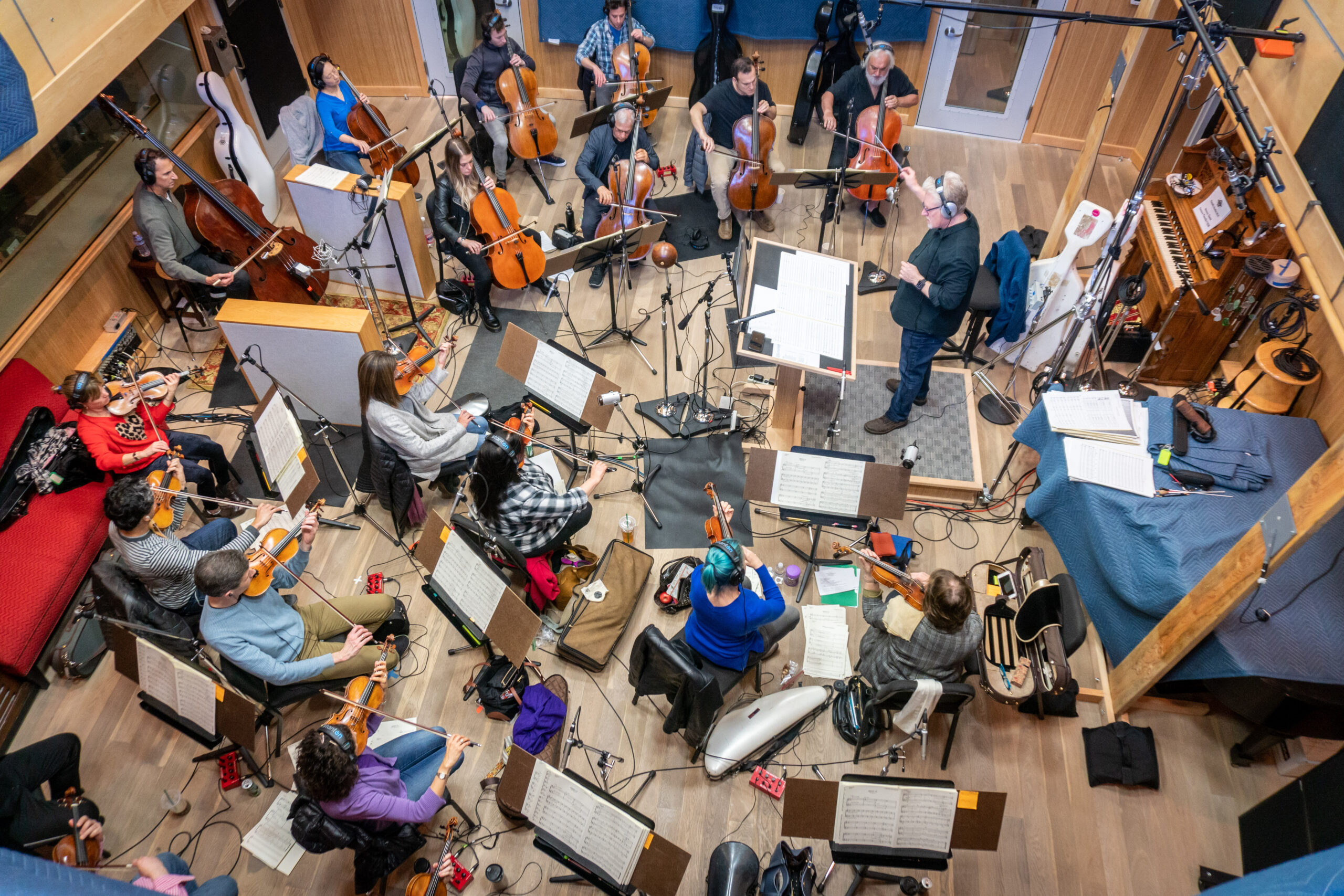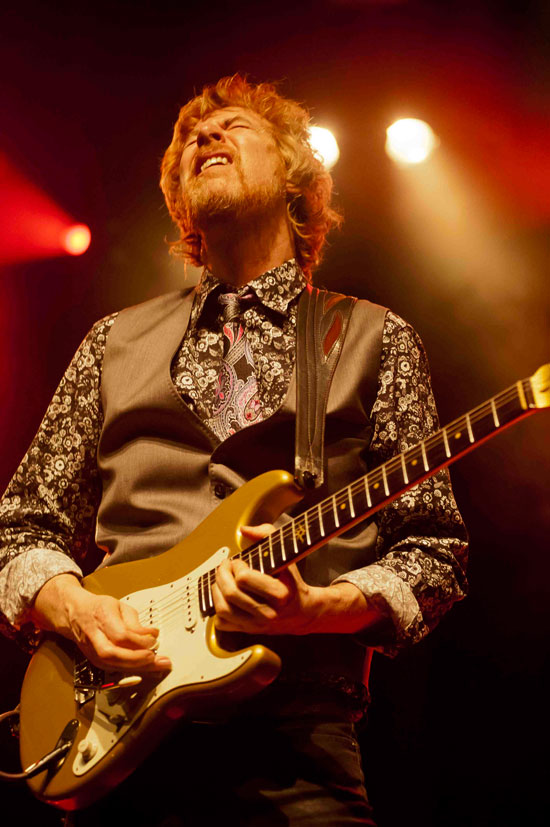Few composers rock with the stylistic eccentricity of Lyle Workman. With Wrecking Crew worthy guitar chops that saw him play alongside the likes of Todd Rundgren, Beck, Frank Black and fellow composer Chad Fischer’s band Lazlo Bane, Workman would translate his sense of rhythm to the instrumental pictures accompanying Jon Favreau’s 2001 feature debut mob comedy “Made.” But it was with Judd Apatow’s loopy 2005 “The 40-Year Old-Old Virgin” where Workman found a particular, peculiar forte becoming the voice of eccentric underdogs. Next applying spot-on funk licks to the notoriously foul-mouthed “Superbad” and winsome alt. pop to “Forgetting Sarah Marshall’s” dejected puppeteer, Workman has since given no end of groovy character to a rogues gallery of outsiders, whether it be the hard rock rush of “Get Him to the Greek,” the unstrung high school athletics of “Win Win,” the rousing Vegas magic of “The Incredible Burt Wonderstone” or the just-so-wrong adolescent antics of “Good Boys.”

Now Lyle Workman applies some of his most catchily offbeat brushstrokes to an orange fro’d Owen Wilson by way of kitsch wunderkind Bob Ross in “Paint.” Channeling the instant PBS artist in name, look and perhaps spirit, Wilson’s Carl Nargle is the Vermont superstar of his rustic small town, an inadvertent lothario to the ladies whose wistfully silent veneer holds the dream of becoming respectable enough to hang in The Burlington Museum of Art. Carl gets his most important inspiration maybe sooner than expected when he tangles colors with the hot young tv rival Ambrosia (Ciara Renee), all the while trying to make it up to his long-suffering ex, and now payback-enabled tv station producer Katherine (Michaela Watkins).

It’s a crisis of conscience that Workman doesn’t express musically by the comedy scoring numbers. Instead, the composer dips into a delightfully offbeat thematic mix of countrified Mexico-by-way of Hawaii rhythms and brass, woeful voices and shuffling percussion with just a dash of orchestra. For Brit McAdams’ drolly dry film, it’s a perfect combination of offbeat peppy colors that quickly spells out Workman’s own whimsically groovy voice when given an manchild to dip into self-realization – an always unexpected rock-pop-alt. born approach that truly makes Lyle Workman an American scoring original in the cinematic theater of the absurd he’s found a comfortable home in.
How did your rock background lead you to scoring?
I moved to Los Angeles in 1997 to pursue more session work, touring, all possible opportunities. I started working as a session guitarist and recorded with a band whose central songwriter was a musician named John O’Brien. John was a friend of Jon Favreau who had asked him to score his film “Made.” John thought he and I would make a great team between our collective skill sets, and that’s how I got my first film.
Not too long afterwards, I played guitar on several film scores for the composer Ed Shearmur. His wife was an executive at Universal Pictures and through that connection, I ended up with the VP of music at Universal in my studio because he was looking to add guitar to his own music. At the end of that session, I sent him off with a demo CD. He responded positively and asked if I would write some additional music for the film “Kicking and Screaming,” starring Will Ferrell. One of the producers was Judd Apatow. Shortly afterwards, Judd signed a directorial deal with Universal Pictures, the first movie being “The 40-Year-Old Virgin.” The VP championed me as composer, and I was sent some scenes to score. Judd liked them and hired me. Having that one and the next Apatow production, “Superbad,” was a collective commercial success that solidified a strong start to a career of film composing.

Do you think that your breakout “The 40-Year Old Virgin” set you on a particular path for playing outsider characters?
I’ve never analyzed it in those terms. The path that was presented certainly featured “outside” characters, but it wasn’t a conscious choice on my part. I could have fallen into dramas or other genres, it just happened to be comedy with these kinds of characters, at least at the outset.

Were you familiar with Bob Ross before you did “Paint?” And what did you think of the painter, and his work that the film deftly satirizes.
I was only peripherally familiar but learned more from watching the 2021Netflix documentary. What a heartbreaking story. What is interesting about “Paint” is that it’s not about Bob Ross. Owen’s character is someone else wholly. The director only borrowed Ross’ look and that he painted landscapes for a PBS show. Other than those two elements, everything else about Owen’s character, Carl Nargle, is completely fictional.
Talk about working with director Brit McAdams.
Brit also wrote the script. He has vision, great sensibilities and puts his trust in the team and sets the stage so they can bring their best. My intention out of gate was to bring something uniquely fitting to the score. What I came up with took a little bit for Brit to process upon first reveal, understandably because it was a strong character on its own and nothing like the music I was replacing. But he grew quickly to embrace it. On a personal front, Brit is a gem of a human being which made our collaboration very enjoyable.

There’s an unplugged Mexico-Hawaii-Country sound for Carl and the locals that you might not necessarily think about for a movie set in Vermont. Where did that idea come from, and could you tell us about its peculiarly fun ensemble?
Before I began writing I had a phone conversation with Owen, who is also executive producer. He referenced Marty Robbins and a song by Dwight Yoakum, and between those two references I began to construct a sonic template for the sound of the score. Some colors that stood out were the pseudo mariachi trumpet and iconic male backing vocals, not unlike Elvis’ background singers The Jordanaires. I thought pedal steel guitar could be an interesting leading texture that could cover the range of emotions and hit both comedic and dramatic beats, if I expanded how it was played beyond its usual role use in country music over to a wider pallet of chordal harmony and melody. That instrument is featured in almost every cue.
Beyond that eccentric style, what other styles did you want to go for here?
The instrumentation of pedal steel, upright bass, jarana (a kind of a Spanish uke with 8 strings), trumpet, drums, percussion and strings were able to service pretty much everything.

You’re used to scoring some pretty uproarious, very adult R-rated comedies with a raucous rock-pop sound. “Paint” is very much the opposite of that with a wryly understated, and very dry PG13 approach. Does that push your further as a composer, especially given that the music couldn’t be as crazy as something like “Superbad?”
The pushing is more about coming up with the idea, not the execution of it, because that’s where my abilities and experience come in to play. I’d never written anything remotely resembling “Superbad” before I landed that film. From my formative years onwards I’ve been stretched through interests in many styles and put into play thorough the wide range of jobs throughout my career as a band member, songwriter, session musician, sideman, producer, etc. I brought all of that into film composing. It was a couple decades of widening the skill set which made the move to film composer logical and organic.
“Paint” is also very much a risen-now-falling redemption story. How did you want to play that, especially when the film becomes more poignant?
In those areas I’m in the character’s state of mind to support the narrative. On a technical level it’s the play with harmony, tone, tempo and texture, and this instrumentation was conductive to traversing those places. I feel that with writing music in general there’s a huge element of the muse in play, or having a kind of antennae to channel inspiration, which I can’t take any credit for.

Given that Carl is a soft-spoken, tight-lipped guy who carries a lot of angst in him, how did you want to get inside his character – or imagine a past we’re never told of here?
I’m looking for any subtext that can bring more dimension to the character or scene; what is unsaid but expressed in the eyes, the physical body. Owen’s Carl was fully formed, the mark of any fine actor, and between the verbal and non-verbal I was able to access what made him tick.
What’s the trick to having fun with characters without the music making fun of them – particularly here when Carl’s biggest fans are locals, PBS watchers and nursing home residents?
Making music that is earnest and bright, not going for something overtly comedic. Unless the director requests, I never accentuate comedy in the music of a comedy. Playing subtext or another angle on the scene is way more interesting and three dimensional. Particularly here, I wanted to highlight the magic Carl has over his fans.
How did you want to capture the idea of painting, particularly when it’s of adorably “populist” art that a museum curator thinks is worthy of a Motel 6?
Actually, I didn’t consider painting at all in the score. I felt that aspect was plenty fleshed out without the need to comment on it through music. I focused on the character’s emotional state, motives, arcs and pushing the story along.

The most effusive, and suddenly orchestral cue in “Paint” is where Carl finally ventures to The Burlington Museum of Art. Tell us about scoring that scene.
Thanks Daniel. That is one of my favorite cues. I wanted to underscore an important moment of Carl’s courage to face his fear. There are strings lightly peppered throughout the score and the biggest dynamic is at the end of this cue where they get big and bold. Carl sees a big blank space on the wall and his imagination is peaked. He’s inspired, and I wanted to illustrate that moment with a big flourish.

You’ve often scored movies with a lot of source music in them, and here “Paint” has a 60’s – early 70’s vibe, as well as featuring the Dolly Parton song “Coat of Many Colors.” How did you want to score to work with those tunes?
That Dolly song is so beatifically placed! As a generally rule I’m not influenced by nor am I considering the songs when I’m writing. For one, it’s not practical because songs are in flux throughout the post process, often not solidified until the very end. I’m creating my own character in the music and it’s nice that the songs vary and comment in their own way. With solid song choices, they organically blend nicely with score because after all, they are reacting to the same thing.
When you look at composers who specialize in a rock-pop-alt. style, how do you think your own voice fits into that genre?
That’s an interesting question but I don’t how my voice fits in relation to any genre or what other composers do. There’s too many nuisances and variables to consider. Everyone has their own voice. I think many composers, myself included, have untapped genres and abilities they don’t get hired for so I’m careful not to put composers in bags based on how they are known. I suppose the scope of my career, scoring and other, is a testament to never seeing a specific lane to stay in, for better or worse.

Do you view yourself as a painter of sorts?
I suppose you can say that figuratively!

“Paint” is now in theaters, and streaming May 23 from IFC Films. Visit Lyle Workman’s website HERE


